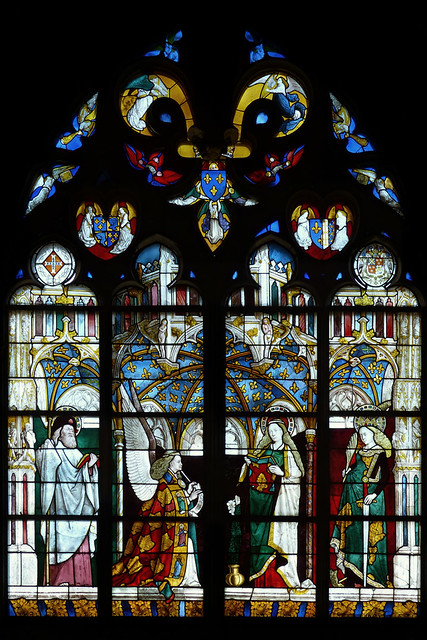The Annunciation - Bourges Cathedral

This four-light window depicts the Annunciation to the Virgin Mary, a masterwork of mid-15th-century French stained glass and one of the earliest panels in the south ambulatory cycle at Bourges Cathedral.
At the centre, the Archangel Gabriel, richly vested in a scarlet cope patterned with gold shells and miniature saintly figures, kneels before the Virgin Mary, who stands at the right holding a book of hours and clothed in green and white robes edged with gold. Between them, a vase of lilies, symbol of purity, rests upon the tiled pavement. The scene unfolds within an elaborate Gothic canopy: a blue ribbed vault adorned with fleurs-de-lis and supporting sculpted angels and figures of Adam and Eve, visually linking the Incarnation to the theme of Redemption.
To the far left stands an aged prophet, possibly Isaiah, holding a scroll that foreshadows the Virgin Birth; to the far right, a crowned female saint bearing a palm and sword, perhaps St Catherine of Alexandria, witnesses the divine encounter.
Style and Iconography
The window is remarkable for its balance of architectural precision and painterly grace. The slender figures, with high foreheads and delicate features, are characteristic of the Loire–Berry school, while the angel’s vestments recall the sumptuous textile patterns of contemporary court art. The saturated blue and ruby tones, enhanced by gold silver-stain highlights, create a luminous harmony typical of the Flamboyant Gothic idiom.
The inclusion of heraldic motifs—the repeated shells and miniature saints on Gabriel’s cope—may allude to the Order of Saint James or a noble patron associated with pilgrimage, further linking this glass to the elite devotional culture of Bourges in the reign of Louis XI.
Attribution and Context
As with the Adoration of the Magi and Donor panels, the Annunciation is attributed to the Bourges Cathedral workshop, active under Jean Lécuyer or André Robin, both maîtres verriers documented in the 1460s–1470s. The unity of colour handling, draughtsmanship, and architectural framing across these windows suggests a single cohesive campaign, likely executed around 1467.
This composition exemplifies the transition between the Gothic linear tradition and the emergent Renaissance naturalism of the Loire Valley, making it a cornerstone of late medieval French glazing.
Condition
Largely original, with minor 19th-century restoration to the border tracery. The brilliance of the enamel and stain remains unusually well-preserved, allowing the fine detailing of Gabriel’s garments and the Virgin’s expression to remain vivid and legible.
